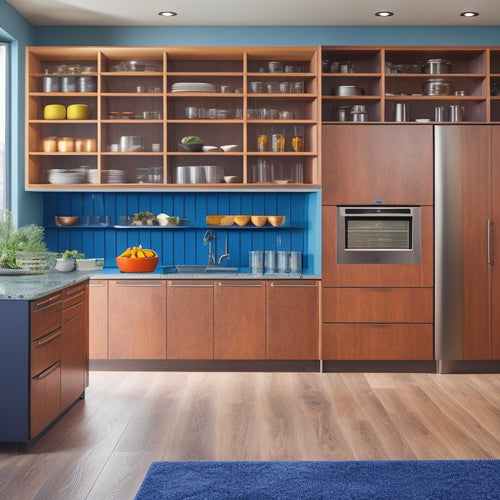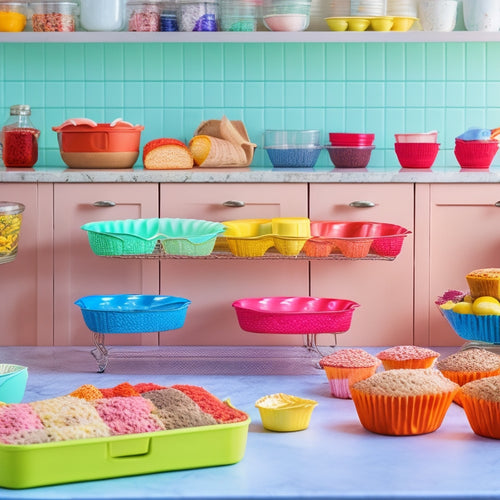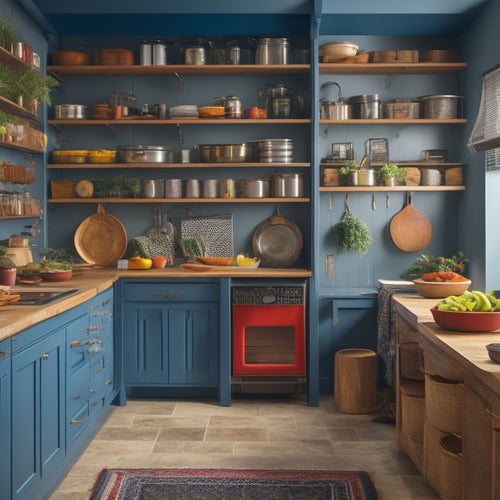
Streamlining Home Kitchen Setup for Business Success
Share
You're ready to take your home-based food business to the next level. Start by evaluating your kitchen infrastructure needs, identifying commercial-grade appliances and necessary tools. Next, understand cottage food regulations, making sure you comply with labeling guidelines and sales restrictions. Then, build a compliant food business by implementing food handling guidelines and prioritizing kitchen organization. Don't forget to guarantee food safety and quality, and protect your business and assets with insurance coverage and legal protection. By streamlining your setup, you'll set yourself up for success - now, take the next step to optimize your operations.
Key Takeaways
• Evaluate your kitchen infrastructure to identify necessary commercial-grade appliances and specialized tools for efficiency.
• Optimize kitchen layout to streamline workflow, reduce waste, and increase productivity.
• Separate personal and business ingredients, and implement a system for tracking inventory and supply chain management.
• Develop a compliance checklist to ensure adherence to cottage food regulations, food safety guidelines, and quality control standards.
• Prioritize kitchen organization, sanitation, and hygiene practices to guarantee the quality of your products and protect your business.
Assessing Kitchen Infrastructure Needs
As you begin setting up your home kitchen for business, take stock of the equipment you already have and identify what's missing to guarantee efficient production. This includes everything from commercial-grade appliances to specialized tools like immersion blenders or food dehydrators.
Conduct an equipment evaluation to determine what's necessary for your specific products and workflow optimization. Next, take inventory of your ingredients, separating personal from business use to ensure accurate tracking and ordering.
Assess your kitchen layout for maximum efficiency, considering the flow of ingredients, equipment, and people. By optimizing your layout, you'll reduce waste, increase productivity, and create a safer work environment.
Understanding Cottage Food Regulations
You're now prepared to navigate the intricate world of cottage food regulations, which will determine how you operate your home-based food business and guarantee compliance with state and local laws. To secure success, you must understand the legal requirements, labeling guidelines, and sales restrictions that apply to your business. Here's a breakdown of key considerations:
| Regulation | Description | Impact on Business |
|---|---|---|
| Labeling Guidelines | Clearly outline ingredients, allergens, and nutritional information | Secures consumer safety and builds trust |
| Sales Restrictions | Limitations on where and how you can sell products | Directly influences revenue and marketing strategies |
| Direct Marketing Opportunities | Allows for direct sales to consumers, farmers' markets, etc. | Enhances revenue potential and customer engagement |
Building a Compliant Food Business
To build a compliant food business, start by implementing proper food handling guidelines and labeling systems that meet cottage food regulations. This will ensure your products are safe for consumption and protect your business from potential lawsuits.
Next, create a compliance checklist to guarantee you're meeting all necessary requirements. This organized approach will help you stay focused on business growth strategies.
A well-organized kitchen is essential for compliance, so prioritize kitchen organization and ingredient sourcing. This will optimize your workflow and contribute to the overall success of your business.
Ensuring Food Safety and Quality
Implement proper food handling guidelines and sanitation practices in your kitchen to prevent contamination and ensure the quality of your products. This is essential for your customers' health and your business's reputation. Establish a quality control system to monitor and maintain high standards.
| Hygiene Practices | Quality Control Measures |
|---|---|
| Wash hands frequently | Regularly test products for quality |
| Clean and sanitize equipment | Implement a recall procedure |
| Store ingredients properly | Monitor product expiration dates |
| Prevent cross-contamination | Conduct regular kitchen audits |
Protecting Your Business and Assets
As you've guaranteed the quality of your products, now it's time to safeguard your business and assets from potential risks and liabilities.
You've worked hard to build your brand, and it's crucial to protect it. Consider investing in insurance coverage that specifically caters to home-based food businesses. This will provide you with financial protection in case of unforeseen events or lawsuits.
Additionally, look into legal protection by forming an LLC or consulting with a legal professional. This will help separate your personal assets from your business, ensuring that your personal belongings are safe in case of any legal issues.
Frequently Asked Questions
How Do I Balance Business and Personal Kitchen Space Efficiently?
You'll efficiently balance business and personal kitchen space by implementing storage solutions like labeled bins and designated shelves, and mastering time management skills, like scheduling prep work and cooking sessions, to keep your spaces separate and safe.
Can I Hire Employees or Contractors to Help With Food Production?
Carefully consider assembling a crew to conquer culinary tasks, outsourcing labor to free up time for you to focus on growth. When hiring help, make sure they're well-versed in food safety protocols to maintain a secure production environment.
What Are the Tax Implications of Running a Home-Based Food Business?
You'll need to understand tax implications, considering deductions for business expenses and choosing a business structure, like an LLC, to minimize personal liability and maximize tax benefits, ensuring you're protected and profitable.
How Do I Handle Food Waste and Disposal in a Home Kitchen Setting?
You tackle food waste by implementing composting solutions, donating excess to local programs, and getting creative with recipes using scraps. Practice portion control to reduce waste, and consider partnering with local organizations for responsible disposal.
Can I Sell My Homemade Products at Local Events or Farmers' Markets?
"Don't worry, you can sell your homemade products at local events or farmers' markets! Develop a marketing strategy, conduct a pricing analysis, and create eye-catching product packaging that showcases your branding techniques to attract customers."
Related Posts
-

Roll-Out Trays for Modular Kitchen Cabinets
Roll-out trays are the perfect addition to your modular kitchen cabinets, enhancing both accessibility and organizati...
-

Roll-Out Trays for Organizing Baking Supplies
Roll-out trays are perfect for organizing your baking supplies, making your kitchen more efficient. They maximize spa...
-

Over-The-Door Kitchen Storage for Large Families
Over-the-door kitchen storage is a transformative solution for large families. It maximizes vertical space, keeping y...


